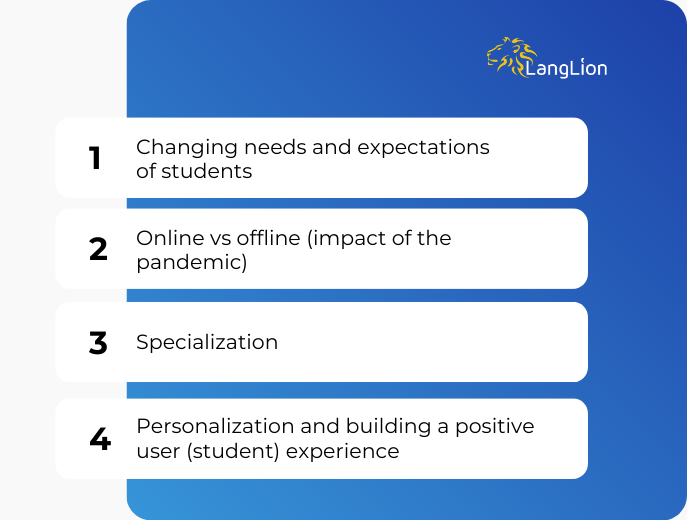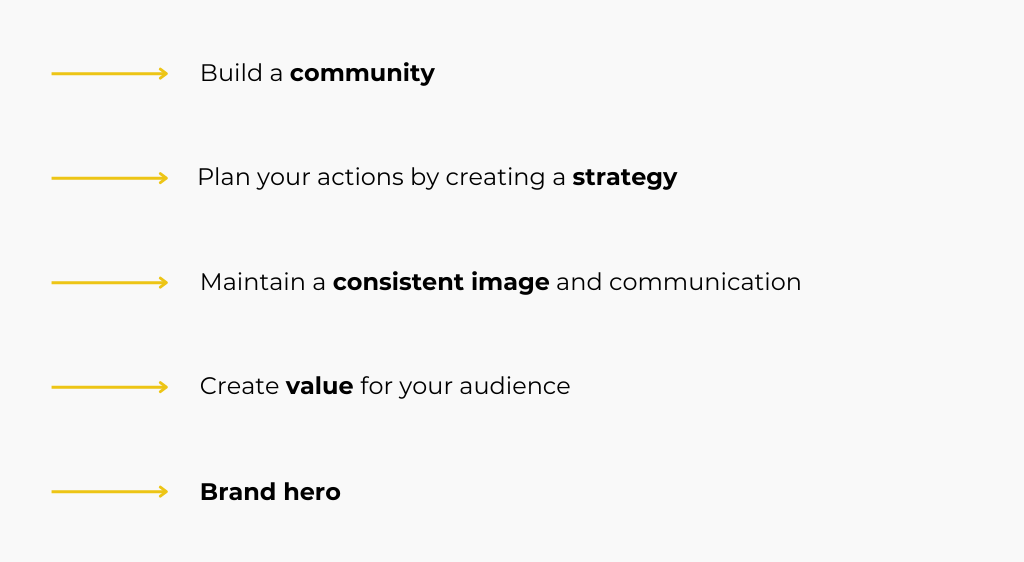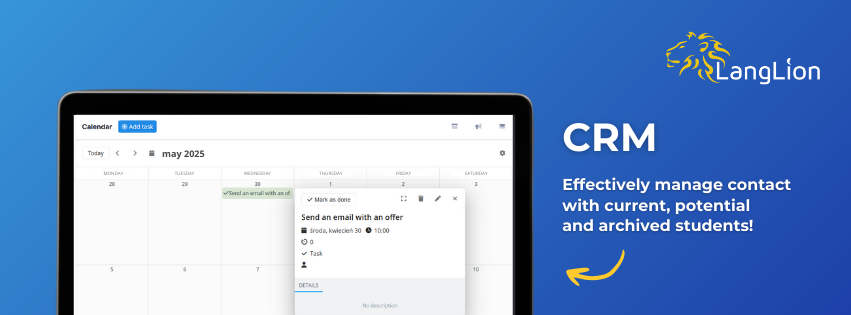
If you run or are planning to start a language school, one of the biggest challenges will be acquiring clients. In a competitive educational market, it is crucial not only to build trust but also to stand out from the competition. In this article, you will learn how to attract clients to your language school, effectively drawing in new students and expanding your institution.
What will you find in this article?
- Trends in language education 2024
- How to understand your target group?
- Where to source data from?
- Strong brand – how to build it?
- Customer Journey Map
- Effective marketing strategies for beginners
- Technology – what to keep in mind?
- Summary – how to acquire clients for a language school in 2024?
Trends in language education 2024
In this section, I will discuss four key changes that have emerged in recent years, especially during the pandemic and post-pandemic periods. Although these are not revolutionary changes, they are worth closely monitoring as they impact the market in subtle yet significant ways. I will try to present these changes along with examples of how they affect the operation of a language school and what threats they may pose.

Changing needs and expectations of students
The first significant trend is the shift in students’ motivation to learn languages. Previously, the main motivation was career development. For children, language learning was often seen as an investment in their future professional life. Adults also frequently learn languages for career advancement, which has become almost a standard in building a career.
However, we now see a growing trend where students’ motivation stems from lifestyle reasons. For example, individuals traveling to Spain for holidays may want to order paella in Spanish to enrich their travel experience. A perfect example is Ola, who started learning Spanish because of her passion for Latin American dances. Such personal motivations can lead to more engaged learning, and understanding these motivations can help reach new target groups.
It is also worth noting that the development of proprietary teaching methods has become a significant trend. Many companies offer ready-made teaching methods that can be implemented from start to finish, which is particularly useful for new schools that may have limited resources. Using proven teaching methods can be a recipe for success and attract customers.
Technology is becoming an integral part of language education. Expectations for technology in teaching are rising, but it is worth remembering that meeting just a few key expectations can already make a big difference. Blended learning, which combines face-to-face classes with online learning, has become the standard. Course participants expect the possibility of self-study outside of classes, access to a variety of educational materials such as e-books, videos, or podcasts, and support from the instructor outside of lesson hours. It is important to ensure that educational materials are attractive and to provide appropriate support for students.
Another noticeable trend is the increasing emphasis on communicative practice, such as conversations with native speakers. The possibility of purchasing additional hours of conversation with a native speaker has become increasingly desirable.
Student motivation can also be supported through various educational projects and competitions that build social relationships and make learning more engaging. Group projects, especially for younger participants, can significantly improve group dynamics and increase motivation.
The intensity of language courses is another significant trend. Clients are increasingly asking about intensive courses, particularly before important events such as holidays or job interviews.
One must not forget the role of certificates and exams, which still hold great value in the job market. It is also worth considering expanding the language school’s offer to include other courses, such as robotics courses, which can distinguish the offer from the competition and increase its attractiveness.
Online vs offline (impact of the pandemic)
The pandemic has significantly impacted the way languages are taught. On one hand, it enabled the widespread implementation of online teaching, which brought many benefits. On the other hand, there have been pitfalls, and schools’ approaches to face-to-face and online teaching vary. Some schools have completely switched to online teaching, which reduces costs, while others have returned to face-to-face classes, especially in the context of children, where social education is of great importance.
Abandoning face-to-face classes can be risky, especially if the school does not have a distinctive offer or specialization. Working on unique selling points and building a personal brand can help maintain competitiveness in the market.
Learn more about the differences between online and on-site classes!
Specialization
In the face of growing competition, many schools decide to specialize. These can be B2B courses, courses for children, intensive courses, or conversation courses. Choosing a specialization can help in standing out in the market and reaching a specific target group.
It is also worth remembering that the language school market in Poland is growing by 5-6% annually. Despite some stagnation, the growth trend is still present, and the need for additional language education is increasing, especially in the context of the declining level of public education.
Online can be a valuable complement to in-person classes, but in many areas, personal contact remains crucial. The final choice of the form of learning should be tailored to the needs of the target group and the specifics of the offered courses.
Personalization and building a positive user (student) experience
Personalisation and building a positive student experience are crucial, especially in the context of competition with large educational platforms. To compete effectively, language schools must provide unique experiences and a high level of customer service.
My personal experience shows that intensive and in-person courses can be just as important as online learning. Contact with other participants and the instructor is a significant element of motivation and the effectiveness of learning. Therefore, it is worth considering how best to combine both approaches to ensure an optimal experience for students.
How to understand your target group?
When establishing a language school, it is crucial to precisely define the target group – the people who might be interested in the courses. We cannot be for everyone, so we must understand who we are directing our marketing efforts towards.
Why is this important? Knowing the target group allows you to tailor the offer to their needs.
This includes:
- Communication channels: where do your potential clients spend their time – is it on Facebook, Instagram, TikTok, or perhaps other places on the internet?
- Communication: what messages and offers will be the most effective?
How to define your target group?
The following points will help you determine the target group you want to reach. First and foremost, pay attention to:
- Demographic data: gender, age, education, profession, income. For example, are you targeting adults who want to learn a language in their free time, or parents of children of a certain age?
- Geographical data: region, city, location. Will your clients come from larger cities or smaller towns? How far are they from your school?
- Psychographic data: lifestyle, interests, motivations. What motivates your target group to learn languages?
- Behavioral data: online activity, product knowledge. Are your potential clients still considering learning a language, or are they already actively searching for courses?
Creating Buyer Personas
Create client profiles that match your target group, so-called Buyer Personas, which will help you better target your marketing campaigns. You can have several Buyer Personas, but try to avoid having too many – it is better to focus on a few key groups.
Cyclical data updates
Remember that Buyer Personas and data about the target group are not static. You must regularly update them based on the information gathered and the changing needs of clients. This is a fundamental element of your marketing strategy, which should be dynamic and flexible.

Where to source data from?
As data sources, we can and should use every possible option that provides us with information. It is thanks to data that we can improve, among other things, our processes, courses, marketing activities, optimize our website, and much more. Even if initially there is little data, over time it will create a fuller picture of the market and your target group.
Analytical tools
When it comes to data collection, the most popular tools currently are Meta statistics and Google Analytics.
- Meta (Meta Business Suite, Business Manager, Ads Manager): These tools allow for the analysis of user locations, positions, education, languages, and devices they use. This tool collects data from Facebook and Instagram.
- Google Analytics: Provides information about website traffic, sources of visits, and user demographics. It collects data within the entire Google environment. It is important to remember to link your Google Ads account with Google Analytics to ensure data consistency.
Customer feedback
These are all the data we receive from our students. We primarily distinguish:
- Comments and reviews: Monitor comments on social media and reviews about you and your competitors. Customer responses can provide valuable insights into their needs and expectations.
- Surveys and interviews: regularly conduct surveys among students and their parents to gather information about the quality of services and their expectations.
- Reviews on Google business cards: Pay particular attention to negative comments, which can highlight areas for improvement.
- GoWork: Analyse reviews about employers to find information on the internal issues of your competitors.
Facebook groups
Join industry groups and monitor discussions. These groups are a good source of knowledge about current trends and customer needs. You can also create your own group to bring together, for example, your clients.
Newsletter
Be sure to collect email addresses! This enables you to send personalized messages to your audience. Track data regarding email opens, link clicks, and the topics that interest your subscribers. This helps in segmenting customers and personalizing communications.
Competitor analysis
Analyze your competitors’ activities – their offers, marketing campaigns, and the comments about them. Observe what they do well and where you can stand out in the market.
Market research at the start
If you are just starting out, first conduct an analysis of the local and national market to understand where you can find your customers. This point is particularly important for offline (stationary) activities.
Strong brand – how to build it?
Building a strong brand is key to success in today’s competitive world. If you want to effectively attract clients to your language school, in addition to teaching foreign languages and courses, you must remember to build a community around your school. It is more than just courses – it’s about creating a space where students feel part of something bigger.
That’s why it’s worth investing in various methods that help build a community. This can be done by creating valuable content, sharing information about the school’s life, and engaging students in activities outside of lessons. As a result, students will feel more connected to our brand and will be more likely to recommend it.
Planning activities is crucial. Contrary to appearances, many companies do not have a written strategy. Although at the beginning the strategy does not have to cover several years ahead, it is worth having at least a plan for a few months or a year. Goals should be clear, and progress regularly verified. Consistency in image and communication is also important. We establish it at the beginning and try to maintain it across various communication channels – on the website, in comments, or on social media.
An important element of brand building – and of shaping the image of a language school – is the Brand Hero: a character associated with the brand. It can be a mascot, like our lion, which appears in all materials. Such a Brand Hero can attract attention, especially in language schools, where mascots appeal to children. Even if the Brand Hero is not a mascot, it’s worth having a person or element that becomes a symbol of the brand and strengthens the overall image of the language school.

Customer Journey Map
The Customer Journey Map is a tool that helps track and analyze the customer’s experiences at various stages of contact with our brand. It is important for the client to have positive experiences from the first contact with our brand until the end of the course. This applies to interactions with both the staff and the product itself.
Everyone associated with our brand, including instructors and administrative staff, should ensure a good image and positive client experience. Taking care of every stage of the client’s journey contributes to their loyalty and desire to continue using our services.
The Customer Journey Map in a language school is, to some extent, the answer to the question how to acquire clients. Once you understand what the client’s path looks like, you can create touchpoints between your brand and the client.
Effective marketing strategies for beginners
Marketing is a department that should primarily focus on attracting clients to a language school. Initially, it is worth concentrating on actions that are effective and not too costly.
- Word of mouth, or recommendations, can be strengthened by ensuring high-quality courses and the entire learning experience.
- Building relationships and community also contributes to positive recommendations.
- Organizing open days, workshops, and competitions can attract new clients and strengthen bonds with existing ones.
- Publishing the successes of students and graduates, such as high exam scores, is also an effective form of marketing.
Maintaining relationships with former students and sharing their success stories can enhance our recommendations. It is good to organize local events that integrate the community and build lasting relationships with students. In the context of choosing between B2B and B2C, it is worth relying on the experience and preferences of customers, remembering that we always sell to people (B2H), regardless of whether they are companies or individual clients.
Traditional marketing, such as leaflets and posters, still works, especially in local communities. Digital marketing is growing in importance, but it is worth investing in it wisely.
Google Business Profile
Google Business Profile is a basic tool that should be prepared and regularly updated. Thanks to it, we are visible on Google Maps, and customers can find complete information about our school, including the address, phone number, and reviews. It is worth encouraging students to leave reviews, which can increase our visibility and positively impact the school’s image.
Make sure to read our articles:
✔︎ how to create a Google Business Profile?
✔︎ Google Business Profile for language school – why is it worthwhile to have one?
Social media
On social media, it is worth sharing information about courses, events, and student successes. Facebook, Instagram, or TikTok (if we have the appropriate resources) are ideal places to publish content that shows our activity and engagement in language education. Posting photos from events, student stories, or short videos can attract attention and increase our online presence.
Content marketing
Content marketing should meet the needs of our target group. Blogs, e-books, webinars, and guides are effective tools. It is important that the content is useful and targeted at the right audience. It is also worth considering content recycling – using one material in various forms and channels. Evergreen content, which remains relevant for a long time, is also a valuable element of a marketing strategy.
An example of effective content marketing is an e-book, which can not only attract attention but also serve as an additional source of income. Such actions help in building a contact base and generating additional income.
Technology – what to keep in mind?
Website
The first place that our potential student is likely to encounter is our website. Unfortunately, many language schools still have websites that look like they are from the nineties. In today’s times, this is unacceptable, and creating a professional website does not have to be costly. It is worth using ready-made templates, which are available for a small amount of money, while still offering a modern look. The website serves as our business card and should be modern and functional.
We observe that many companies limit themselves to just having a presence on Facebook, which is a mistake. The website should be our own property and not depend on the changing algorithms of Facebook. Therefore, it is crucial that the website is well planned. A domain with a .com extension is the most advantageous because it is well-positioned. One can also consider the .edu .com domain, but .com is a solid choice. It is worth investing in a modern, refreshed logo that will look professional. The cost of refreshing an existing logo is usually lower than creating a new one, and it improves the perception of the website.
The loading speed of a language school’s website is crucial. It is necessary to regularly check how the website functions on different devices and under various network conditions. The website should be responsive, meaning it should look good on computers, tablets, and phones. It should also be clear and not overloaded with information. If possible, it’s worth providing the prices of services on the website, as customers do not want to search for this information.
Contact information should be easily accessible. It often happens that customers cannot find the phone number or email address, which leads to situations where they call us instead of the language school. Let’s make it easier for them to get in touch. There should also be a visible registration form, which should not contain many fields – a name, surname, email, and possibly a phone number will suffice. A quick response to inquiries is crucial, preferably on the same business day.
When it comes to blogs and social media, it is important to keep them up-to-date. If we do not have time to maintain a blog regularly, it is better to abandon this element than to leave it with outdated posts. It is better to have fewer but regularly updated content.
Email marketing
Email marketing is an effective tool if we have gathered a database of contacts. Thanks to it, we can maintain contact with students, promote courses, and convey important information. It is crucial that acquiring contacts is done in accordance with GDPR regulations. Email marketing tools, such as MailerLite, can significantly ease the work.
They offer automation, ready-made templates, and integrations, which save time. Personalisation is key – we should segment our contact base to deliver personalized messages. We can send different communications to adults, children, parents, and companies, and even further segment the base so that each message is as tailored to the recipient as possible.
CRM
CRM is an important tool for managing relationships with potential and existing clients. Unfortunately, many schools still use simple tools like Excel or notebooks to track contacts. It is worth investing in a CRM that allows effective contact management and task assignment.
LangLion is a language school management system that offers a CRM module. It integrates with the system and enables contact management without the need for external tools. Thanks to the CRM, we can track the history of interactions with students, which makes it easier to manage relationships and customer service. Read more about the CRM module!

Paid campaigns
Paid campaigns can be an effective complement to marketing activities, but they require an appropriate budget and knowledge. It is important to ensure that our website and other marketing activities are well-prepared before starting a campaign. Paid campaigns, such as Google Ads or ads on Facebook and Instagram, should be used at appropriate times, such as before the new school year.
Collaborating with advertising agencies can be beneficial, as experts can help set up, monitor, and optimize the campaigns. It is also worth using remarketing to reach people who have already visited our site, as acquiring such customers is usually easier.

Summary – how to acquire clients for a language school?
An effective marketing strategy requires time and consistency. It is crucial that activities are continuous and regular. New solutions should be tested, their effects analysed, and the strategy adjusted based on the obtained data. Marketing is a process that demands repetition and commitment.
We should not expect immediate results from a single action. Consistency and measuring results are the foundation of effective marketing. Engage in activities that yield results and abandon those that do not work. Finally, it is worth remembering that running a language school turns us into entrepreneurs, and we must focus not only on the quality of courses but also on marketing and sales.
Take care of current clients by offering added value and ensuring exceptional experiences. When it comes to directing marketing efforts towards teenagers, remember that it is the parents who pay for the services, so communication should be tailored to their needs and expectations.
Take control of your marketing! Download our free ebook, Independent Audit of Language School Marketing, and uncover ways to improve your strategy.
